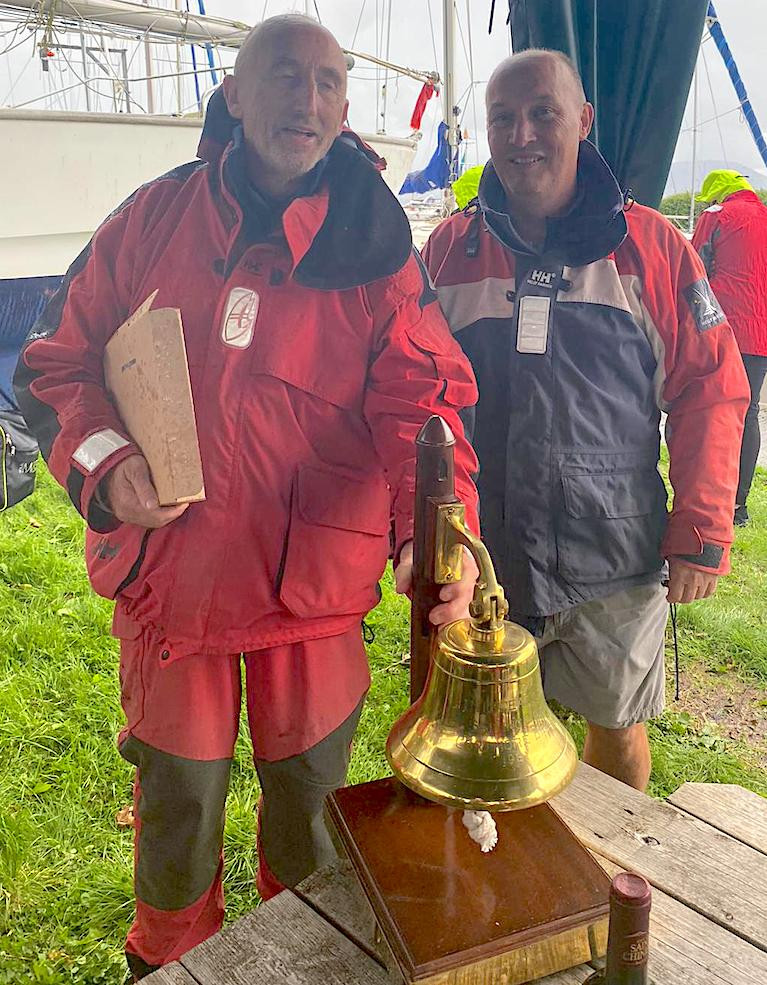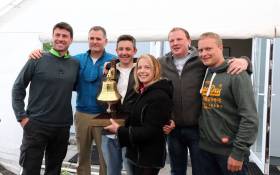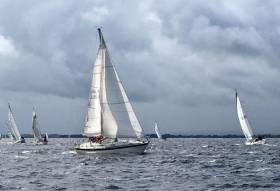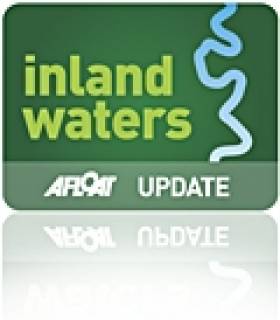Displaying items by tag: Iniscealtra Sailing Club
Yacht Racing is Thriving on Lough Derg's Garykennedy and Iniscealtra Sailing Clubs
Yacht racing on Ireland's inland waters is thriving, with clubs holding regular events on Lough Derg throughout September.
Garykennedy Sailing Club and Iniscealtra Sailing Club have a friendly relationship and often host events together, allowing committee members to have time off from constantly organising events every weekend. This smaller arrangement is worth considering for clubs in other areas where they are growing throughout the island.
Dan O'Connell, a club Sailing Secretary, said, "We are getting regular fleets of 15-20 boats on Saturday afternoons." "This keeps Sundays free for family activities both on and off the water", he added.
A visit to Garykennedy last weekend by Afloat showed the fleet finishing up after the Ciss Ryan Cup race. Although it was windy on the west coast, the sailors' relaxed faces were coming ashore after a shortened course of an hour and a half. Some commented that the winds were too light for spinnakers.
Garykennedy S.C. has two warm clubhouses overlooking the lake, offering full bar service and excellent food in the name of Ryans and Larkins Hosptilaries. By 4 pm, the club was bustling both inside and outside in pleasant sunshine, with members in their dry sailing gear while the weather was approaching. A buffet was in full swing, provided by the Ryan family, keeping the members together for the presentation of prizes.
 The winning crew on "Celtic Charisma", a Kelt 29, accepting the Ciss Ryan Cup from Roy and Denise Breen (from L-R) Tadgh Murphy Commodore, Nigel and Sue Smithwick, with their son and grandchildren Neil and Alison McCormack and young Oscar and Luca McCormack Photo: Patricia George
The winning crew on "Celtic Charisma", a Kelt 29, accepting the Ciss Ryan Cup from Roy and Denise Breen (from L-R) Tadgh Murphy Commodore, Nigel and Sue Smithwick, with their son and grandchildren Neil and Alison McCormack and young Oscar and Luca McCormack Photo: Patricia George
Pierce Purcell of Galway Bay S.C. visited to keep an eye on the west's inland sailing and to commend both Garykennedy and the Mountshannon Clubs on their running of the recent Gortmore Bell Race and weekend activity.
RNLI cheque
 Philip Despard Iniscealtra Sailing Club, Ger Murphy ISC sailing Captain, Dr John Killeen, Irish Trustee RNLI, Niamh McCutcheon RNLI and LDYC, Pierce Purcell Galway, and Tadgh Murphy, Commodore of Garykennedy SC and Peter O'Callaghan, ISC Photo: Patricia George
Philip Despard Iniscealtra Sailing Club, Ger Murphy ISC sailing Captain, Dr John Killeen, Irish Trustee RNLI, Niamh McCutcheon RNLI and LDYC, Pierce Purcell Galway, and Tadgh Murphy, Commodore of Garykennedy SC and Peter O'Callaghan, ISC Photo: Patricia George
John Killeen, Irish Trustee RNLI, and Niamh McCutcheon of Lough Derg RNLI were there to receive a cheque worth €1,600 raised by members of both clubs.
Dr Killeen expressed his gratitude on behalf of RNLI to the sailors for their contribution and praised the volunteers with crews on call throughout the year. He also informed the gathering that the RNLI would be celebrating its 200th anniversary in 2024.
Pat Lawless presentation
Pat Lawless, a Golden Globe sailor, was presented with life membership of Garykennedy to a standing ovation.
 Golden Globe sailor Pat Lawless with Brendan O’Connor, Garykennedy Sailing Club Vice Commodore on his boat Vamoose competing in the Ciss Ryan trophy
Golden Globe sailor Pat Lawless with Brendan O’Connor, Garykennedy Sailing Club Vice Commodore on his boat Vamoose competing in the Ciss Ryan trophy
He had earlier given a most entertaining talk on his Golden Globe race entry. One could feel his relaxed passion in the room as he gave encouragement to the gathering to enter the race. Being a former West Coast fisherman, nothing seemed to daunt him, as he shared that he would go below to read books or cook for some hours, sleeping only for 20 minutes at a time.
He took pride in his boat and the accuracy of his navigation, not to mention the wonderful support of his sponsor Green Rebel, his family, and friends. Pat is now saving for the next Golden Globe race in 2026.
 Garykennedy Sailing Club Master of Ceremonies, Brendan O'Connor, with Commodore Tadgh Murphy presenting Golden Globe sailor Pat Lawless with life membership of Garykennedy SC Photo: Patricia George
Garykennedy Sailing Club Master of Ceremonies, Brendan O'Connor, with Commodore Tadgh Murphy presenting Golden Globe sailor Pat Lawless with life membership of Garykennedy SC Photo: Patricia George
Sea Saw Wins Iniscealtra Sailing Club's Gortmore Bell Race
The Iniscealtra Sailing Club annual Gortmore Bell Race took place on Lough Derg on Saturday, 5th September. With a forecast of 15 to 20 knots westerly and sunshine, it promised to be a good day sailing for the 28-boat fleet.
The class 2 boats started 30 mins earlier than class 1 with ‘Sea Saw, a Halberg Rassey 352 leading on the water in the nice reaching conditions. In class 1, it was ‘Sonic Boom’, an SB20, that led the fleet out and enjoyed the fast reaching conditions to overtake class 2 and reach the turning mark off Gortmore point in just under 1hr 45min.
 A 28-boat fleet raced for the Gortmore Bell on Lough Derg
A 28-boat fleet raced for the Gortmore Bell on Lough Derg
The fleet enjoyed a long forereach south from Gortmore and it was Passet Partout in class 1, a Dufour Classic who made big gains on this leg. As the wind rose from the west it led to a challenging beat from Mountaineer buoy back to Mountshannon, especially for the smaller boats in the fleet.
It was See Saw helmed by Ken O’Farrell in class 2 that won out, in the end, to claim the Gortmore Bell trophy with Passet Partout, sailed by Joe Gilmartin winning Class 1 and Sonic Boom the first home of the SB20 fleet.
Gortmore Bell Race On Lough Derg Won By Sadler 32 'An Seabhac'
The Iniscealtra Sailing Club annual Gortmore Bell race from Mountshannon on Lough Derg took place on Saturday 7th September. The wind was 10 to 15 knots from the South generally all day moving South West later in the race, which gave the fleet of 22 boats a long downwind leg to the Gortmore Mark at the Northern end of the lake and a long upwind leg home.
Class 2 set off 30 minutes ahead of class 1 and after racing for just under 5 and a half hours, the line honours was taken by the class 2 Kelt 29 'Celtic Charisma' only 12 seconds ahead of the class 1 SB20 'Deakin Marine'.
In class 1, Dan O'Donnell's Hanse 'Dash' took the win from the Dufour 36 'Passe Partout' with the J24 'Luder' taking third place.
Class 2 saw a great battle between a number of boats reeling back the years and sailing very well in the conditions. The Jeanneau Arcadia 'Reflex' took third place behind the Westerly Longbow 'Serendipity' but sailing very consistently across the day gave Jonathan Ryan and crew on the Sadler 32 'An Seabhac' the class 2 and overall win in the 2018 race.
LaBamba Claims Gortmore Bell Race on Lough Derg
The Gortmore Bell Race, sponsored by Union Chandlery took place this Saturday on Lough Derg with 23 boats taking part across two classes.
This is the lough's longest race in the calendar from Iniscealtra Sailing Club’s base in Mountshannon to the Gortmore mark near Portumna and home via Mountaineer rock buoy near Domineer.
Class 2 got underway first at 10:45 followed 30 min later by class 1 at 11:15 in a NW breeze which was set to increase as the morning went on. 1st around the Gortmore mark and heading for home was Serendipity helmed by Robert Bourke, first around in Class 1 was Jumping Jack Flash helmed by Dominic O’Sullivan. The breeze increased to 30–kts at times which made for exiting reaching conditions for the three SB20’s in the fleet who managed to hold they asymmetric spinny’s from Coose mark to Mountaneer bouy. Line honours was claimed by the SB20 Jumping Jack Flash followed quickly by the rest of the fleet with all boats finished by 16:40pm.
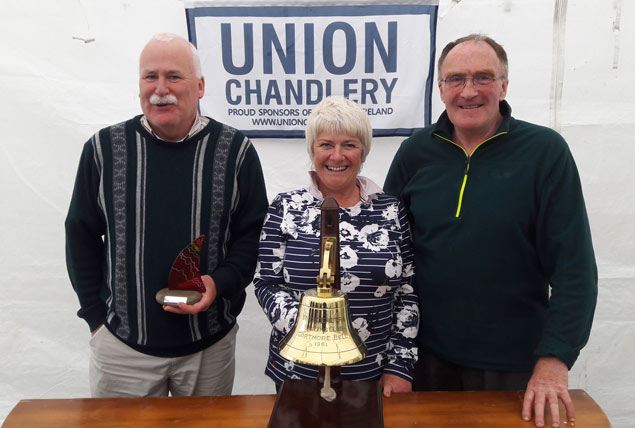 Gortmore Bell Winners 2017 – (from left to right) Sean Collins, Mary and Mike Sadlier of La Bamba
Gortmore Bell Winners 2017 – (from left to right) Sean Collins, Mary and Mike Sadlier of La Bamba
1st Place Overall and in Class 1 was LaBamba helmed by Mary Sadlier and crewed by Mike Sadlier and Sean Collins, 1st Place in Class 2 was Serendipity helmed by Robert Bourke, 1st Place in J24 fleet was Jobs for the Buoys, helmed by Barney Power and 1st place in SB20 fleet was claimed by Jonathan Foley’s Jumping Jack Flash helmed by Dominic O’Sullivan.
Full results attached below for download.
Iniscealtra's Hanse 34 Wins Lough Derg's Long Distance Gortmore Bell Prize
#loughderg – Iniscealtra Sailing Club and Garykennedy Sailing Club hosted the annual 24–mile long Gortmore Bell Race on Lough Derg at the weekend, 36 sailing boats ranging from one design types such as 1720s and J24s plus a good mix of 28ft to 34ft cruiser–racers competed. Conditions for the Lough's long distance race were ideal with wind speeds ranging from eight and 14 knots from the north–east.
The course for the 2014 race was from a start Line in Mountshannon Bay to the Gortmore Green Navigation Mark rounded to Port, thence to Coose Bay Red Navigation Mark to port, Mountaineer Green Navigation Mark to starboard and a finish in Mountshannon Bay.
The winning boat boat was the Hanse 34 sailing cruiser, Dash, skippered by Dan O'Donnell of Iniscealtra Sailing Club.
Iniscealtra Sailing Club
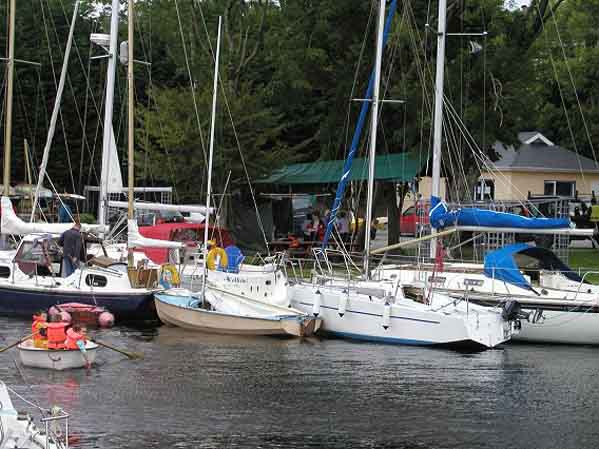
Above: Harbour View. Photo: Gerard Stundon
Iniscealtra Sailing Club (ISC) is located on the shores of Lough Derg at Mountshannon, Co Clare, Ireland. It takes its name from the nearby monastic island known as Inis Cealtra or Holy Island (English).
The club was founded in the late sixties and is comprised mainly of a sailing cruiser fleet. Initially the small number of boat owners met, socialised and raced from the main harbour in Mountshannon. Most members hailed from the Limerick region.
However with the increase in numbers gathering, plus the increase in boats using the main harbour, the club looked around the immediate area and made a decision to purchase a prime site on the shores of the lake, adjacent to the main harbour, from where they could run the club events. In 1984 the club formed as a company limited and in 1985 land was purchased by the club, adjacent to the public harbour in Mountshannon. The deeds were signed and ISC became the proud owners of the new club site. Plans to develop this land were started and today a fine harbour, club house, parking and recreational areas have been developed and nurtured by the loyal members. The number of members increased and the interest in sailing and racing the sail boats grew progressively.
In the late ‘80s, plans were drawn up for a club house facility which has now been built and comprises of toilet facilities, showers, kitchen and a meeting/general use room. There is on shore water and power with berthing facilities to tie along side. The site is private and maintained by the members and allows for families and sailors to meet and socialise together when using their boats. A small slip allows sailors to access their moorings with the use of the club dinghy. The depth of the water is approximately 6-7 foot providing sufficient depth for most sailing boats.
The club is run by a committee who meet monthly to discuss all the club activities, planned events, racing calendar and other general issues. The committee operates on a voluntary basis and work to provide a well run, family orientated and sporting club for all members. The aim is to provide facilities for both larger and smaller boats and to introduce junior members to dinghy sailing.
(The above information and image courtesy of Iniscealtra Sailing Club)
Iniscealtra Sailing Club, Mountshannon, Co. Clare. Membership information and application forms from Der O'Mahony, 12 Tullyglass Court, Shannon, Co. Clare. Tel: 086 342 8333, email: [email protected]
Have we got your club details? Click here to get involved


























